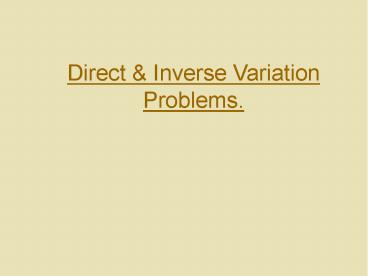Direct - PowerPoint PPT Presentation
Title:
Direct
Description:
Direct & Inverse Variation Problems. Examination Questions. Direct & Inverse Variation Problems. Examination Questions. Example 1. If W varies directly with F and ... – PowerPoint PPT presentation
Number of Views:144
Avg rating:3.0/5.0
Title: Direct
1
Direct Inverse Variation Problems.
2
Example 1.
If W varies directly with F and when W 24 , F
6 . Find the value W when F 10.
Solution.
When F 10 W ?
When W 24, F 6
3
Example 2.
If g varies directly with the square of h and
when g 100 , h 5 . Find the value h when
g 64.
Solution.
When g 64 , h ?
When g 100 , h 5
h 4 or h - 4
4
Example 3.
If d varies inversely with w and when d 3 ,
w 9 . Find the value d when w 3.
Solution.
When w 3 d ?
When d 3 , w 9
d 9
k 27
5
Example 4 .
If r varies inversely with the square root of
f and when r 32 , f 16. Find f when r 32.
Solution.
When r 32 , f ?
When r 32 , f 16.
k 128
6
Example 5 .
If t varies jointly with m and b and t 80 when
m 2 and b 5. Find t when m 5 and b 8 .
Solution.
When m 5 , b 8 , t ?
When t 80 , m 2 and b 5
7
Example 6 .
c varies directly with the square of m and
inversely with w. c 9 when m 6 and w
2 . Find c when m 10 and w 4 .
Solution.
K ½
When c 9 , m 6 and w 2
When m 10 , w 4 and c ?
12.5
8
Examination Questions.
- Example 1.
- The time,T minutes ,taken for a stadium to empty
varies directly as the number of spectators , S,
and inversely as the number of open exits, E. - Write down a relationship connecting T,S and E.
It takes 12 minutes for a stadium to empty when
there are 20 000 spectators and 20 open exits.
(b) How long does it take the stadium to empty
when there are 36 000 spectators and 24 open
exits ?
9
Solution.
(a)
Now S 36 000 and E 24 .
K is the constant of variation.
Substitute.
(b)
T 12 , S 20 000 and E 20
Substitute to find the value of K.
Cross multiply.
T 18 minutes
20 000 K 20 x 12
10
Example 2.
The number of letters, N , which can be typed on
a sheet of paper varies inversely as the square
of the size, S , of the letters used.
(a) Write down a relationship connecting N and S .
(b) The size of the letters used is doubled.
What effect does this have on the number of
letters which can be typed on the sheet
of paper ?
Solution.
(b)
Letter size 2S
(a)
By doubling the size of letters the number of
letters is quartered.
11
Example 3.
A frictional force is necessary for a car to
round a bend. The frictional force , F
kilonewtons , varies directly as the square of
the cars speed , V metres per second, and
inversely as the radius of the bend, R metres.
(a) Write down a relationship between F, V and R.
A frictional force of 20 kilonewtons is necessary
for a car , travelling at a given speed , to
round a bend.
(b) Find the frictional force necessary for the
same car , travelling at twice the given speed ,
to round the same bend.
12
Solution.
(a)
By doubling the speed the frictional force F
required to round the bend becomes 4 times
greater.
(b)
Let the speed 2V
F 4 x 20 80































